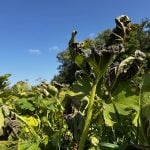WASHINGTON, D.C. – It’s time for America to end the food versus fuel debate, says U.S. agriculture secretary Tom Vilsack.
Instead, he said the country needs to tackle a more important question: could double cropping produce enough grain and biomass to satisfy the demand for both ethanol and breakfast cereal?
During an address to reporters attending the North American Agricultural Journalists annual meeting in Washington, D.C. April 12, Vilsack said the discussion around growing crops for food or fuel is a “false debate.”
Read Also

Trade war may create Canadian economic opportunities
Canada’s current tariff woes could open chances for long-term economic growth and a stronger Canadian economy, consultant says — It’s happened before.
A more appropriate debate would be: how can farmers increase crop production on the existing land base to satisfy both demands?
“Shouldn’t we be asking whether or not the agricultural production system can be re-designed in such a way to meet the needs of the country in terms of its food supply, meet the needs of its livestock industry …
domestically produce fuel, which helps create jobs … and provides more energy security for the country,” Vilsack said.
“A Michigan State study has suggested that perhaps as much as 80 to 200 million dry tons of material could be produced with a double cropping system in this country.”
Bruce Dale, a chemical engineering professor and associate director of Michigan State’s Biomass Conversion Research Laboratory, wrote the study, which was published in the November 2010 edition ofEnvironmental Science and Technology.
He concluded that double cropping one-third of the United States’ 50 million acres of corn and soybean land would make it possible to produce nearly 400 billion litres of ethanol annually without decreasing U.S. food production or agricultural exports.
“We’re predicting (an additional) 100 billion gallons (380 billion litres) of total ethanol could be produced from existing croplands in the United States,” said Dale, who appeared before a U.S. Senate hearing on fuel production alternatives in late March.
“Of that, 20 billion (74 billion litres) would be from corn and 80 billion (296 billion litres) would be from cellulose materials.”
The U.S. uses imported oil to produce 500 billion litres of gasoline annually.
Dale said double cropping could help generate 400 billion litres of ethanol annually, which would replace 80 percent of the gasoline that comes from imported oil.
He said the corn belt of the American Midwest is the ideal location for double cropping.
“That corn and soybean acreage where you get lots of winter rain, (where) you don’t irrigate.”
He said winter rye is the ideal double crop because it would produce a significant amount of biomass.
“It’s just a crop that’s well adapted. Winter wheat or winter oats would do just as well (in certain parts of the corn belt).”
Most of the journalists who attended Vilsack’s presentation concluded that the idea of double cropping one-third of U.S. corn and soybean acres is a pipe dream.
Dale said it is a typical response.
“Initially (the reaction is) kind of a disbelief that we have this much unused productive capacity,” he said.
“(But) by growing winter rye, you can generate about 200 million dry tons per year of the double crop, plus be able to harvest more corn stover from that land.”
He also said it’s difficult for the public to accept the idea of double cropping for biofuel because the existing fuel and energy infrastructure is tilted toward petroleum.
“Ninety percent of the market is controlled by gasoline … and we have to get serious about opening up the fuel market to competition.”
Dale agreed that it’s time to stop asking if we should or shouldn’t grow crops for biofuel and start figuring out how to efficiently grow crops for biofuel.
“This endless dithering only serves the entrenched oil interests. It doesn’t serve the public,” he said.
“A large part of the transportation market requires liquid fuels…. The only way to get those, in a sustainable way, is from plant material.”















